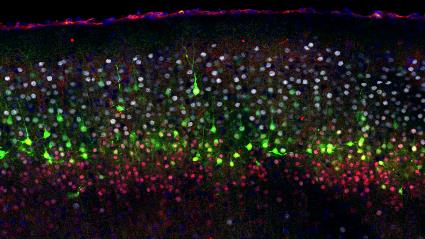Electricity sparks neuronal diversity

© Jabaudon, UNIGE / The diversity of cortical neurons can be highlighted by molecular markers, displaying cells with different morphologies and connectivities.
he cerebral cortex is a highly developed brain region, which allows intellectual functions such as conscious perception, anticipation of events and language. These functions are mediated by specific sets of neuronal circuits.
To understand how these circuits emerge during development, researchers from the University of Geneva (UNIGE), Switzerland, in collaboration with an american team, investigated what enables neuronal stem cells to generate successive subtypes of neurons as the embryo grows. By measuring the electrical activity of these progenitors, they found that akin to a battery getting charged, membrane voltage values increase as the embryo develops and new neurons are being created. To test the role of this electrical charge, neuroscientists experimentally manipulated progenitor voltage values, which allowed them to select which type of neuron was being born.
These results, published in Cell, reveal an unexpected role for bioelectric cell properties in the generation of neuronal diversity.
The cerebral cortex is characterized by a diversity of neuronal cell type which assemble during development to form circuits, underlying functions such as skilled movements and sensory integration. These circuits emerge in two stages: first during embryogenesis, when neurons are born, and later on after we are born, when neurons contact each other to form circuits that are chiseled by the environment.
In the embryo, different types of cortical neurons are sequentially created in a well-defined order by stem cells called neuronal progenitors, located deep within the brain. “We wondered how these progenitors were able to know what type of neurons to make at each embryonic age,” explains Denis Jabaudon, professor in the Department of Basic Neurosciences at the Faculty of Medicine of the UNIGE.
Electricity drives progenitor behaviour
To address this question, the UNIGE team took an unusual approach. “Usually genes are considered as the stars of cellular development, explains Ilaria Vitali, a researcher in the team. Here, we focused on another player, the electrical properties of these progenitors.”
While the role of electrical properties in the normal workings of neuronal circuits is well established, there was until now only little information on a role for electrical charge in progenitor properties. Using a pipette smaller than two microns in diameter to pierce the cell membrane, the neuroscientists were able to measure the electrical charge of neuronal progenitors as the cortex was forming in mouse embryos. “What we found is that as the embryo grows and the types of neurons generate become more complex, progenitor voltage values increased,” says Denis Jabaudon.
An electrical switch to generate distinct neuronal subtypes
To manipulate this process, the scientists next genetically modified embryonic cells. “We expressed small synthetic channels at the surface of the progenitors, which allowed us to manipulate their voltage at will by charging or discharging these cells,” explains Sabine Fièvre, a co-author in the study and researcher in the UNIGE team. “And it turns out that if the progenitors are artificially charged early in embryogenesis, they prematurely generate normally later-born neurons.” “Conversely, if we discharge the progenitors, they generate neurons that are normally born earlier in the embryo’s life,” adds Denis Jabaudon.
These results demonstrate that the bioelectric activity of progenitors plays a central role in generating neuronal diversity. This could help explain how some neurological disorders associated with abnormal electrical activity, such as epilepsy, affect brain development during embryogenesis.
Author : Communication Department, UNIGE >
14 Aug 2018